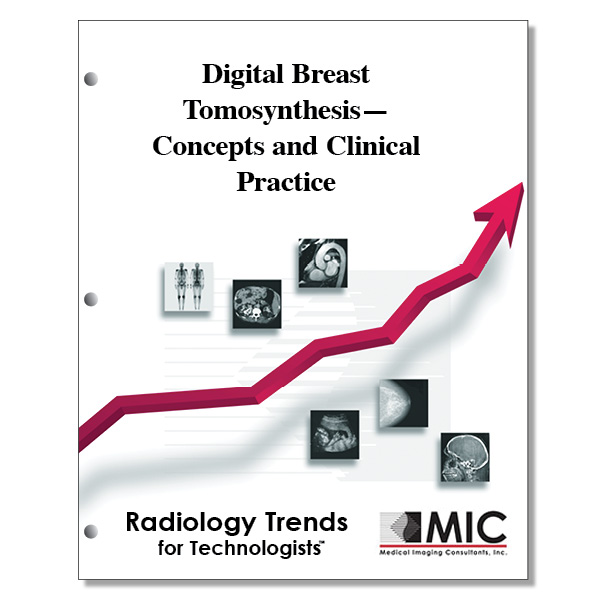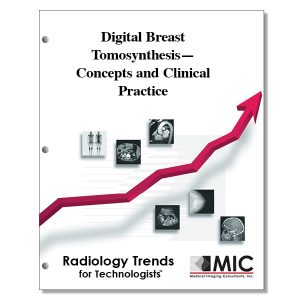

Digital Breast Tomosynthesis—Concepts and Clinical Practice
A review of screening outcomes, tips for lesion localization and characterization, changing workflows for diagnostic imaging, and future developments in digital breast tomosynthesis.
Course ID: Q00596 Category: Radiology Trends for Technologists Modality: Mammography2.75 |
Satisfaction Guarantee |
$29.00
- Targeted CE
- Outline
- Objectives
Targeted CE per ARRT’s Discipline, Category, and Subcategory classification for enrollments starting after January 27, 2023:
[Note: Discipline-specific Targeted CE credits may be less than the total Category A credits approved for this course.]
Mammography: 2.00
Image Production: 1.00
Image Acquisition and Quality Assurance: 1.00
Procedures: 1.00
Anatomy, Physiology, and Pathology: 0.50
Mammographic Positioning, Special Needs, and Imaging Procedures: 0.50
Outline
- Introduction
- Screening Outcomes
- Cancer Detection Rate
- Recall Rate
- False-Negative and Interval Cancer Rates
- Advantage of DBT in Lesion Evaluation
- Lesion Localization
- Lesion Conspicuity
- Calcifications
- Architectural Distortion
- Asymmetries
- Masses
- Cancer Conspicuity according to View
- Practice Considerations
- Decreased Mammographic Workup
- SM Examination
- Use of the Breast Imaging Reporting and Data System with DBT
- Tomosynthesis-guided Biopsy
- Biopsy Rates and PPV3
- Reimbursement and Cost Considerations
- Dense Breast and Supplemental Screening
- Future of DBT Imaging
- Conclusion
Objectives
Upon completion of this course, students will:
- recall the x-ray tube arc range for DBT image acquisition
- describe the benefits of a larger angular range of the x-ray tube during DBT
- describe the length of acquisition and interpretation time associated with DBT
- state the standard of care for both screening and diagnostic breast imaging
- give the cancer detection range when digital breast tomosynthesis plus FFDM is utilized as a screening tool
- list the findings from the Kim et al study
- describe how prospective and retrospective DBT studies have demonstrated lower recall rates
- interpret data regarding retrospective U.S. study comparisons
- define false-negative as it pertains to mammographic screening
- give the alternative name for reconstructed image stacks associated with DBT
- recall the first step when locating the nipple in DBT reconstructed images
- state whether a narrow or wide arc of the x-ray tube in DBT gives the thinnest reconstructed section
- list the factors that may compromise the resolution of each individual calcification in DBT
- recall the study that evaluated calcification conspicuity and found no significant difference between synthesized mammography and FFDM alone or with DBT
- describe why it is important to assess for motion during DBT acquisition if imaging with DBT plus synthetic mammography is performed without FFDM
- state the most commonly missed abnormality in interval cancers
- recall the study that found a positive predictive value for biopsies performed of 26% for architectural distortions that were otherwise occult at FFDM and ultrasound
- state when additional breast imaging should be performed when architectural distortion is seen only with DBT imaging
- tell which modality should be considered the next step if there is a suspicion of distortion even if visualized on only one view at DBT
- list types of benign fatty breast masses
- list the assessment factors for malignant fat containing lesions seen at DBT
- state the type of breast cancer that is more commonly seen only on one view due to field of view limitation
- describe the DBT view in which studies have shown cancers to be more conspicuous
- describe the study in which cancers were significantly more conspicuous on the craniocaudal view than on the mediolateral oblique view with both FFDM and DBT
- list the two views needed for a complete breast screening evaluation
- discuss the study that found FFDM spot compression views to provide no more diagnostic value over those with DBT imaging
- give the number of women involved in the Tomosynthesis Assessment Clinic Trial
- discuss the efficiency of DBT
- list the limitations of DBT plus FFDM
- list the pitfalls and artifacts associated with synthetic mammography
- provide an alternate name for bright-band artifact
- state what BI-RADS stands for
- list the outcomes of the Raghu et al study
- state the recommendations for BI-RADS category 3 follow-up
- recall the outcome of the Schrading et al study
- state the year in which the Ambinder et al study took place
- list the advantages of DBT guidance for biopsy
- state the year when the Centers for Medicare and Medicaid Services approved DBT without copayment for screening indications
- list the main drivers of economic value in implementing DBT at the population level
- list potential indirect cost savings for patients receiving DBT
